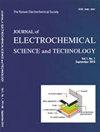熔盐电沉积从废硬质合金中回收钨的机理
IF 3
4区 工程技术
Q3 ELECTROCHEMISTRY
Journal of electrochemical science and technology
Pub Date : 2022-12-23
DOI:10.33961/jecst.2022.00675
引用次数: 2
摘要
废碳化物(YG8)的积累不仅污染环境,还造成钨、钴等稀有金属资源的浪费。为了更好地解决这个问题,我们提出了一种低温水溶液和高温熔盐对钨和钴的联合电化学分离工艺。H2 WO4是由废碳化物在水溶液中获得的,我们将其煅烧以获得WO3,该WO3用作通过熔盐电沉积获得钨的原料。研究了W(VI)的放电析出对电流效率和电化学行为的影响。煅烧结果表明,WO3的形态是规则的,不存在其他杂质。在一系列电沉积实验中,获得了82.91%的最大电流效率。根据XRD和SEM分析,回收的产物为高纯度钨,属于简单的立方晶系。在W(VI)还原机理实验中,采用线性扫描伏安法(LSV)和计时电流法在三电极体系中研究了W在NaCl-Na2-WO4-WO3熔盐中的电化学过程。LSV表明,W(VI)在阴极分两步还原,电极反应由扩散控制。计时电流法拟合结果表明,W(VI)的成核机制为瞬时成核模式,扩散系数为7.379×10-10 cm2·s-1。本文章由计算机程序翻译,如有差异,请以英文原文为准。
Mechanism of Tungsten Recovery from Spent Cemented Carbide by Molten Salt Electrodeposition
The accumulation of spent carbide (YG8), not only pollutes the environment but also causes waste of tungsten, cobalt and other rare metal resources. To better address this issue, we proposed a combined electrochemical separation process of low-temperature aqueous solution and high-temperature molten salt for tungsten and cobalt. H 2 WO 4 was obtained from spent carbide in an aqueous solution, and we calcined it to obtain WO 3 , which was used as a raw material to obtain tungsten by using molten salt electrodeposition. The influence of the current efficiency and the electrochemical behavior of the discharge precipitation of W(VI) were also studied. The calcination results showed that the morphology of WO 3 was regular and there were no other impurities. The maximum current efficiency of 82.91% was achieved in a series of electrodeposition experiments. According to XRD and SEM analysis, the recovered product was high purity tungsten, which belongs to the simple cubic crystal system. In the W(VI) reduction mechanism experiments, the electrochemical process of W(VI) in NaCl-Na 2 WO 4 -WO 3 molten salt was investigated using linear scanning voltammetry (LSV) and chronoamperometry in a three-electrode system. The LSV showed that W(VI) was reduced at the cathode in two steps and the electrode reaction was controlled by diffusion. The fitting results of chronoamperometry showed that the nucleation mechanism of W(VI) was an instantaneous nucleation mode, and the diffusion coefficient was 7.379×10 -10 cm 2 ·s -1 .
求助全文
通过发布文献求助,成功后即可免费获取论文全文。
去求助
来源期刊

Journal of electrochemical science and technology
ELECTROCHEMISTRY-
CiteScore
6.30
自引率
8.10%
发文量
44
期刊介绍:
Covering fields:
- Batteries and Energy Storage
- Biological Electrochemistry
- Corrosion Science and Technology
- Electroanalytical Chemistry and Sensor Technology
- Electrocatalysis
- Electrochemical Capacitors & Supercapcitors
- Electrochemical Engineering
- Electrodeposition and Surface Treatment
- Environmental Science and Technology
- Fuel Cells
- Material Electrochemistry
- Molecular Electrochemistry and Organic Electrochemistry
- Physical Electrochemistry
- Solar Energy Conversion and Photoelectrochemistry
 求助内容:
求助内容: 应助结果提醒方式:
应助结果提醒方式:


